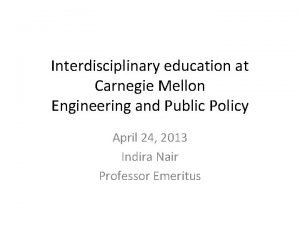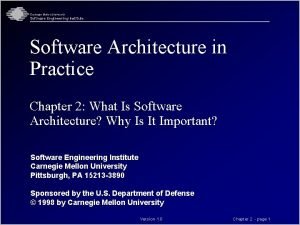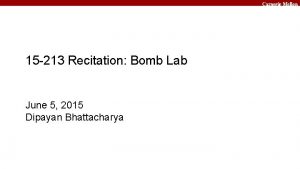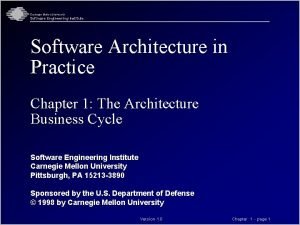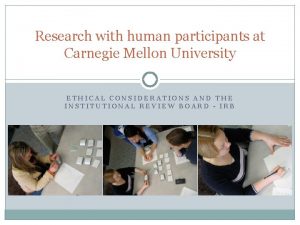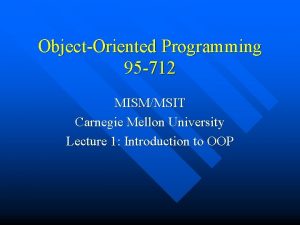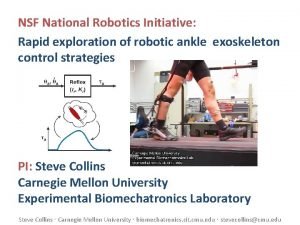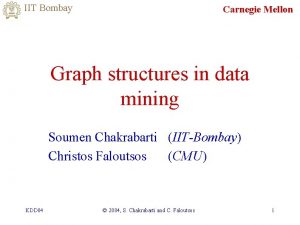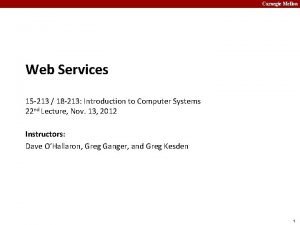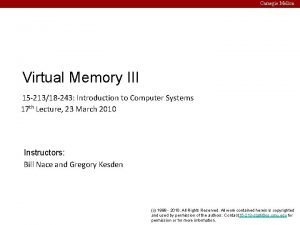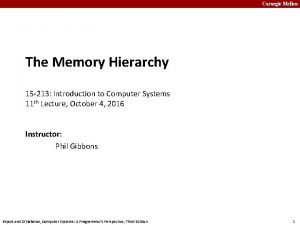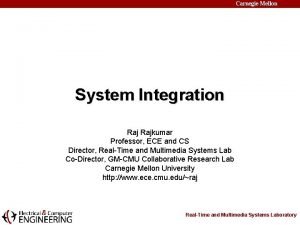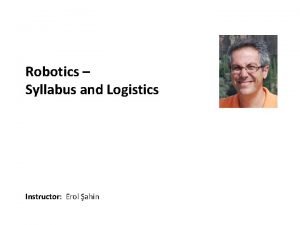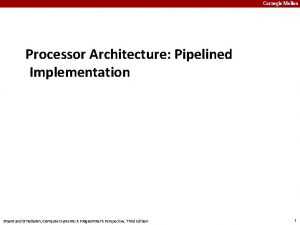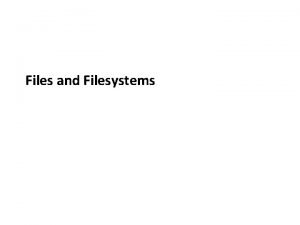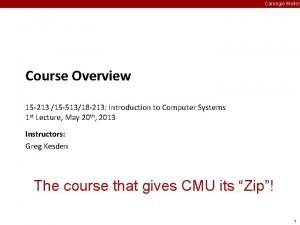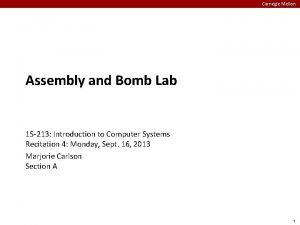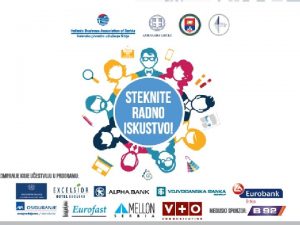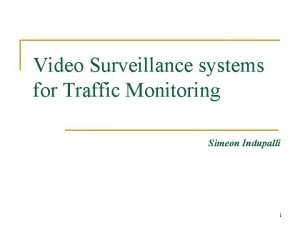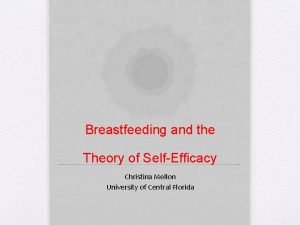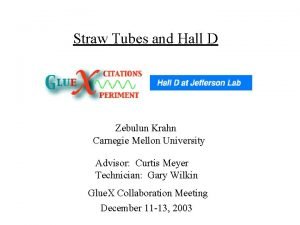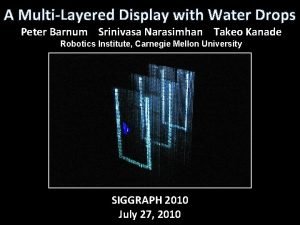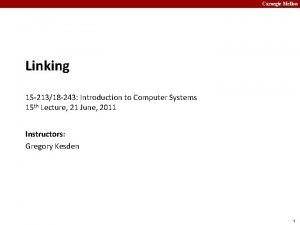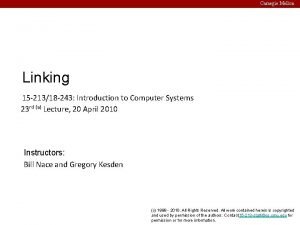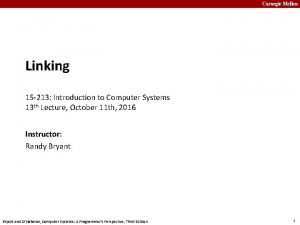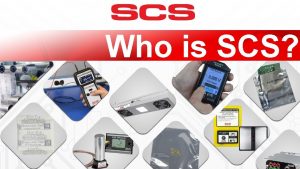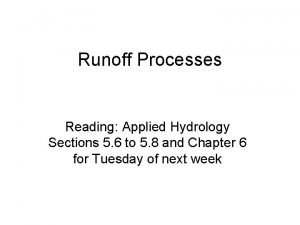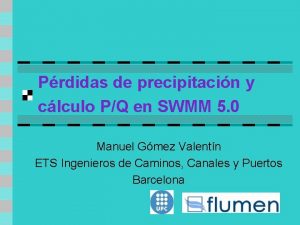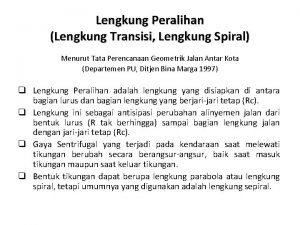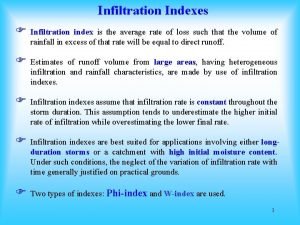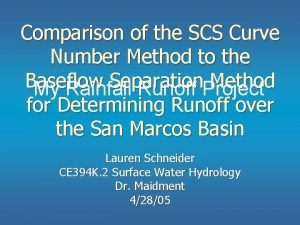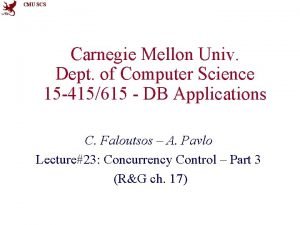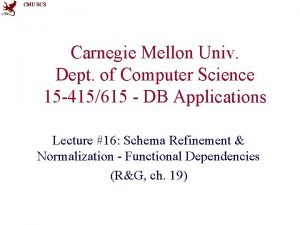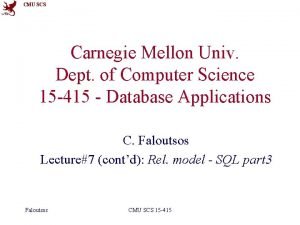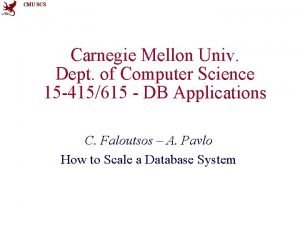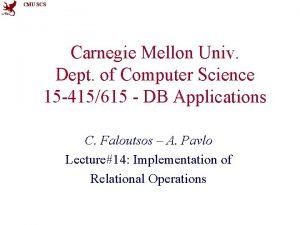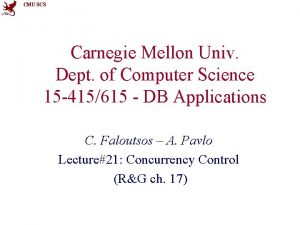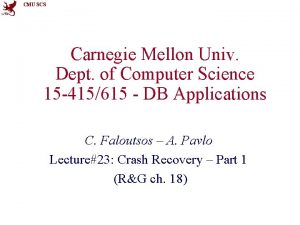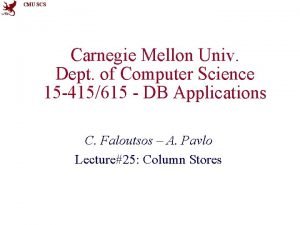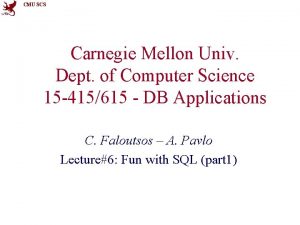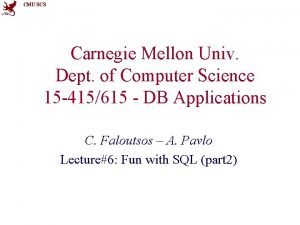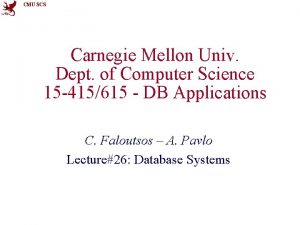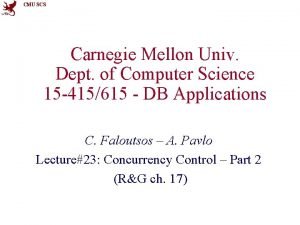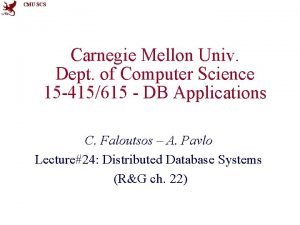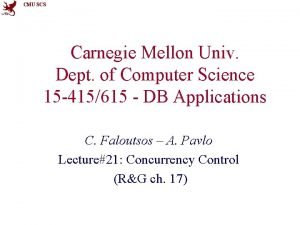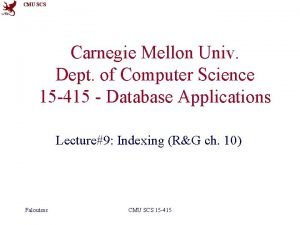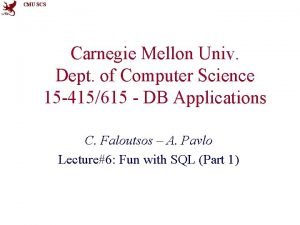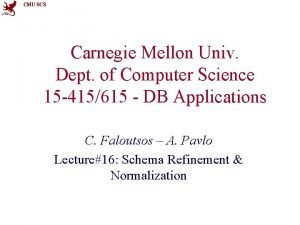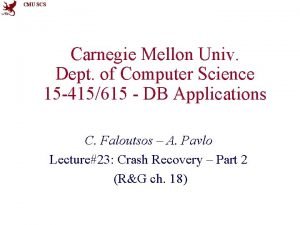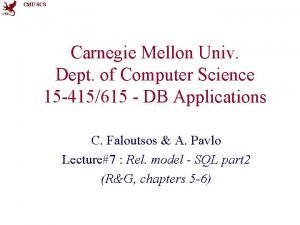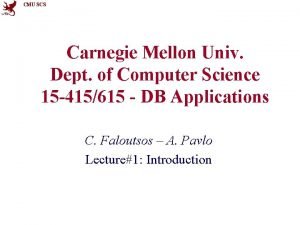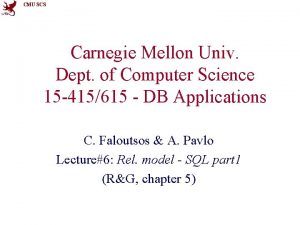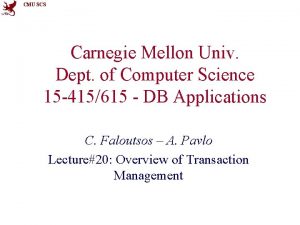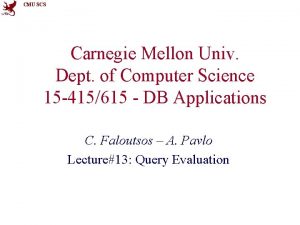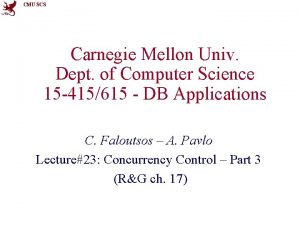CMU SCS Carnegie Mellon Univ Dept of Computer


































- Slides: 34

CMU SCS Carnegie Mellon Univ. Dept. of Computer Science 15 -415/615 - DB Applications C. Faloutsos – A. Pavlo Lecture#28: Modern Systems

CMU SCS System Votes Mongo. DB Google Spanner/F 1 Linked. In Espresso Apache Cassandra 32 22 16 16 Cloudera Impala Deep. DB SAP HANA Cockroach. DB 5 2 1 1 Facebook Scuba Apache Hbase Volt. DB Redis Vertica 16 14 10 10 5 Sci. DB Influx. DB Accumulo Apache Trafodion 1 1 Faloutsos/Pavlo CMU SCS 15 -415/615 2

CMU SCS

CMU SCS Mongo. DB • Document Data Model – Think JSON, XML, Python dicts – Not Microsoft Word documents • Different terminology: – Document → Tuple – Collection → Table/Relation 4

CMU SCS Mongo. DB • A customer has orders and each order has order items. Customers R 1(cust. Id, name, …) � Orders R 2(order. Id, cust. Id, …) � Order Items R 3(item. Id, order. Id, …) 5

CMU SCS Mongo. DB • A customer has orders and each order has order items. Customers { "cust. Id" : 1234, "cust. Name" : “Trump", "orders" : [ { "order. Id" : 10001, "order. Items" : [ { "item. Id" : "XXXX", "price" : 19. 99 }, { "item. Id" : "YYYY", "price" : 29. 99 } ] }, { "order. Id" : 10050, "order. Items" : [ { "item. Id" : “ZZZZ", "price" : 49. 99 } ] } Customer Orders Order Item ⋮ Order Items 6

CMU SCS Mongo. DB • JSON-only query API • Single-document atomicity. – OLD: No server-side joins. Had to “pre-join” collections by embedding related documents inside of each other. – NEW: Server-side joins (only left-outer equi) • No cost-based query planner / optimizer. 7

CMU SCS Mongo. DB • Heterogeneous distributed components. – Centralized query router. • Master-slave replication. • Auto-sharding: – Define ‘partitioning’ attributes for each collection (hash or range). – When a shard gets too big, the DBMS automatically splits the shard and rebalances. 8

CMU SCS Mongo. DB • Originally used mmap storage manager – No buffer pool. – Let the OS decide when to flush pages. – Single lock per database. 9

CMU SCS Mongo. DB • Version 3 (2015) now supports pluggable storage managers. – Wired. Tiger from Berkeley. DB alumni. http: //cmudb. io/lectures 2015 -wiredtiger – Rocks. DB from Facebook (“Mongo. Rocks”) http: //cmudb. io/lectures 2015 -rocksdb 10

CMU SCS

CMU SCS Linked. In Espresso • Distributed document DBMS deployed in production since 2012. • Think of it as a custom version of Mongo. DB with better transactions. • Replace legacy Oracle installations – Started with In. Mail messaging service CMU SCS 15 -415/615 12

CMU SCS Linked. In Espresso • Support distributed transactions across documents • Strong consistency to act as a single sourceof-truth for user data • Integrates with the entire data ecosystem CMU SCS 15 -415/615 13

CMU SCS Linked. In Espresso Centralized Query Router Cluster management system in charge of data partitioning Pub/Sub message bus that supports timeline consistency. Source: On Brewing Fresh Espresso: Linked. In's Distributed Data Serving Platform, SIGMOD 2013 14

CMU SCS

CMU SCS History • Amazon publishes a paper in 2007 on the Dynamo system. – Eventually consistency key/value store – Partitions based on consistent hashing • People at Facebook start writing Cassandra as a clone of Dynamo in 2008 for their message service. – Ended up not using the system and releasing the source code. CMU SCS 15 -415/615 16

CMU SCS Apache Cassandra • Borrows a lot of ideas from other systems: – Consistent Hashing (Amazon Dynamo) – Column-Family Data Model (Google Big. Table) – Log-structured Merge Trees • Originally one of the leaders of the No. SQL movement but now pushing “CQL” Faloutsos/Pavlo CMU SCS 15 -415/615 17

CMU SCS Consistent Hashing 1 0 h(key 1) E A N=3 C F h(key 2) B D Source: Avinash Lakshman & Prashant Malik (Facebook) 1/2 18

CMU SCS Column-Family Data Model Source: Gary Dusbabek (Rackspace) 19

CMU SCS LSM Storage Model • The log is the database. – Have to read log to reconstruct the record for a read. • Mem. Table: In-memory cache • SSTables: – Read-only portions of the log. – Use indexes + Bloom filters to speed up reads • See the Rocks. DB talk from this semester: http: //cmudb. io/lectures 2015 -rocksdb 20

CMU SCS

CMU SCS Two-Phase Commit OK OK Application Server Phase 1: Prepare Node 2 OK Participant Coordinator Participant Commit Request Phase 2: Commit OK Node 1 Faloutsos/Pavlo Node 3 CMU SCS 15 -415/615 22

CMU SCS Paxos 23

CMU SCS Paxos • Consensus protocol where a coordinator proposes an outcome (e. g. , commit or abort) and then the participants vote on whether that outcome should succeed. • Does not block if a majority of participants are available and has provably minimal message delays in the best case. – First correct protocol that was provably resilient in the face asynchronous networks Faloutsos/Pavlo CMU SCS 15 -415/615 24

CMU SCS Paxos Agree Accept Node 2 Agree Propose Accept Node 3 Agree Accept Node 1 CMU SCS 15 -415/615 Node 4 Acceptor Proposer Commit Acceptor Application Server Faloutsos/Pavlo Acceptor Commit Request 25

CMU SCS Paxos Agree Accept Node 2 Propose Node 3 Agree Accept Node 1 CMU SCS 15 -415/615 Node 4 Acceptor Proposer Commit Acceptor X Application Server Faloutsos/Pavlo Acceptor Commit Request 26

CMU SCS Paxos Proposer Acceptors Proposer Propose(n) Agree(n) Propose(n+1) Commit(n) Reject(n, n+1) Agree(n+1) Commit(n+1) Accept(n+1)

CMU SCS 2 PC vs. Paxos • 2 PC is a degenerate case of Paxos. – Single coordinator. – Only works if everybody is up. • Use leases to determine who is allowed to propose new updates to avoid continuous rejection. Faloutsos/Pavlo CMU SCS 15 -415/615 28

CMU SCS Google Spanner • Google’s geo-replicated DBMS (>2011) • Schematized, semi-relational data model. • Concurrency Control: – 2 PL + T/O (Pessimistic) – Externally consistent global write-transactions with synchronous replication. – Lock-free read-only transactions. 29

CMU SCS Google Spanner CREATE TABLE users { uid INT NOT NULL, email VARCHAR, PRIMARY KEY (uid) }; CREATE TABLE albums { uid INT NOT NULL, aid INT NOT NULL, name VARCHAR, PRIMARY KEY (uid, aid) } INTERLEAVE IN PARENT users ON DELETE CASCADE; users(1001) �albums(1001, 9990) �albums(1001, 9991) users(1002) �albums(1002, 6631) �albums(1002, 6634) 30

CMU SCS Google Spanner • Ensures ordering through globally unique timestamps generated from atomic clocks and GPS devices. • Database is broken up into tablets: – Use Paxos to elect leader in tablet group. – Use 2 PC for txns that span tablets. • True. Time API 31

CMU SCS Google Spanner Set A=2, B=9 Set A=0, B=7 Application Server T 1 A=1 T 2 NETWORK B=8 Node 2 Node 1 Paxos or 2 PC 32

CMU SCS Google F 1 • OCC engine built on top of Spanner. – In the read phase, F 1 returns the last modified timestamp with each row. No locks. – The timestamp for a row is stored in a hidden lock column. The client library returns these timestamps to the F 1 server – If the timestamps differ from the current timestamps at the time of commit the transaction is aborted 33

CMU SCS Andy’s Final Comments • Both My. SQL and Postgres are getting very good these days. • Avoid premature optimizations. Faloutsos/Pavlo CMU SCS 15 -415/615 34
 Cmu computational biology
Cmu computational biology Carnegie mellon interdisciplinary
Carnegie mellon interdisciplinary Carnegie mellon software architecture
Carnegie mellon software architecture Cmu bomb threat
Cmu bomb threat Carnegie mellon software architecture
Carnegie mellon software architecture Cmu sparcs
Cmu sparcs Mism carnegie mellon
Mism carnegie mellon Randy pausch time management
Randy pausch time management Carnegie mellon what is rpa robotic process automation
Carnegie mellon what is rpa robotic process automation Iit
Iit 18-213 cmu
18-213 cmu Cmu vpn
Cmu vpn Carnegie mellon
Carnegie mellon Carnegie mellon
Carnegie mellon Carnegie mellon
Carnegie mellon Carnegie mellon
Carnegie mellon Carnegie mellon fat letter
Carnegie mellon fat letter Carnegie mellon
Carnegie mellon Cmu bomb lab
Cmu bomb lab Mellon serbia iskustva
Mellon serbia iskustva Carneigh mellon
Carneigh mellon Conclusion of breastfeeding
Conclusion of breastfeeding Wageworks health equity
Wageworks health equity Mellon tubes
Mellon tubes Water mellon
Water mellon Mellon elf
Mellon elf Mellon elf
Mellon elf Mellon elf
Mellon elf Desco industries rochester nh
Desco industries rochester nh Applied hydrology
Applied hydrology Lluvia neta
Lluvia neta Tikungan spiral spiral
Tikungan spiral spiral Scs cn method of runoff estimation
Scs cn method of runoff estimation Dioda diac
Dioda diac Scs curve number
Scs curve number

